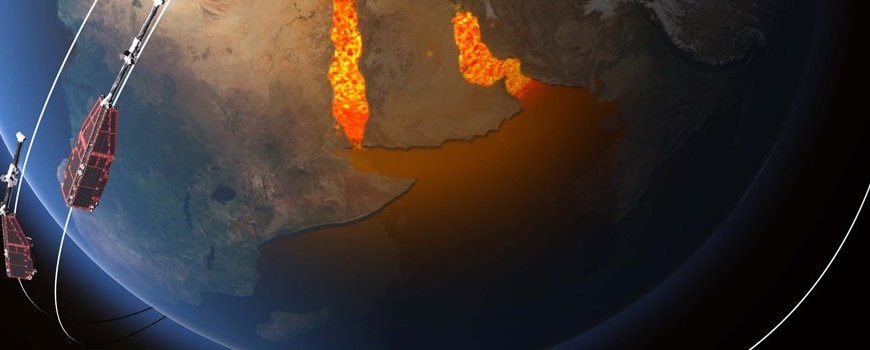The upper atmosphere is ionized due to solar radiation, it is called the ionosphere. Strong variations in electron density can harm trans-ionospheric navigational signals, such as from GALILEO or GPS, and hence constantly disturb navigation. Near the equator, so called “plasma irregularities” regularly develop during sunset and globally build the most severe interruptions of these trans-ionospheric signals. Advances in understanding the development of these ionospheric “storms” is crucial for its prediction, so for the safeguard of our modern society.
Juan Rodriguez-Zuluaga and Claudia Stolle from GFZ section Geomagnetism analyzed unique measurements of the Earth’s magnetic field and the ionospheric electron density onboard ESA’s Swarm satellite mission and revealed the true energy flow associated with these irregularities.
This novel insight, that would not have been possible without high-precision observations from the Swarm mission, has brought crucial new knowledge in the understanding of plasma physics in the upper atmosphere. Thus, the prediction of equatorial plasma irregularities will be improved, and expected, but avoidable wrong navigation through satellite systems, such as GALILEO or GPS, can be quantified better. (jz)
Original study: Rodríguez-Zuluaga, J., Stolle, C., 2019. Interhemispheric field-aligned currents at the edges of equatorial plasma depletions. Scientific Reports, 9, 1233. DOI: 10.1038/s41598-018-37955-z








![[Translate to English:] Torsten Sachs in front of a climate station on a field](/fileadmin/_processed_/3/9/csm__TorstenSachs_bearbeitet_GS_4a1365ef84.jpeg)

![[Translate to English:] left image flood at the Ahrtal: image from above, several houses are flooded; left image:: Heidi Kreibich;](/fileadmin/_processed_/4/4/csm_Bild2_9af0130e9f.png)



![[Translate to English:] Start der Vega Rakete](/fileadmin/_processed_/6/4/csm_20231201-kachel_Vega-VV23-launch_ESA-CNES-Arianespace_706716b68c.jpeg)









![[Translate to English:] Poster exhibition at the Brandenburg Hydrogen Day at the GFZ, some participants in the foreground](/fileadmin/_processed_/6/5/csm_Erster_Brandenburgischer_Wasserstofftag_GFZ_402fcec95e.jpeg)
![[Translate to English:] Group picture of the participants](/fileadmin/_processed_/9/4/csm_20231108_CAWa-Workshop-Tashkent_Gruppenbild_99ea779d8a.jpeg)

![[Translate to English:] [Translate to English:] Hörsaal](/fileadmin/_processed_/e/6/csm_H%C3%B6rsal_e21ac645fb.jpeg)


![[Translate to English:] The Delegations in the Historic Library on the Telegrafenberg. In the back there are from left to right, the Dutch Ambassador for Germany, Ronald van Roeden, the Dutch Minister for Education, Culture and Science, Robbert Dijkgraaf and the scientific director of the GFZ, Susanne Buiter.](/fileadmin/_processed_/d/b/csm_Kachel-2_9eba4b4212.jpeg)

